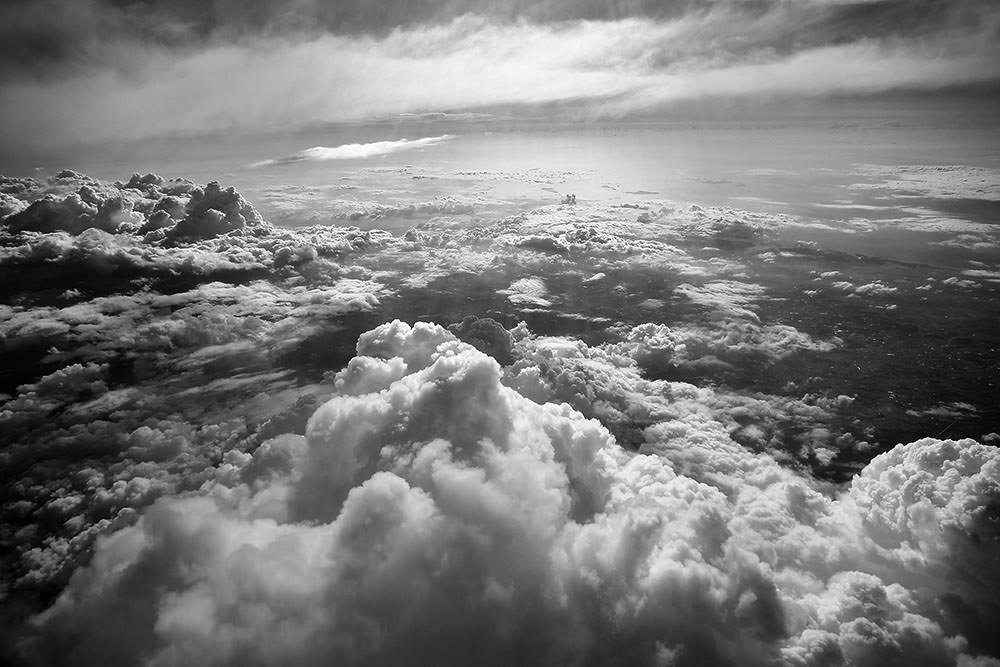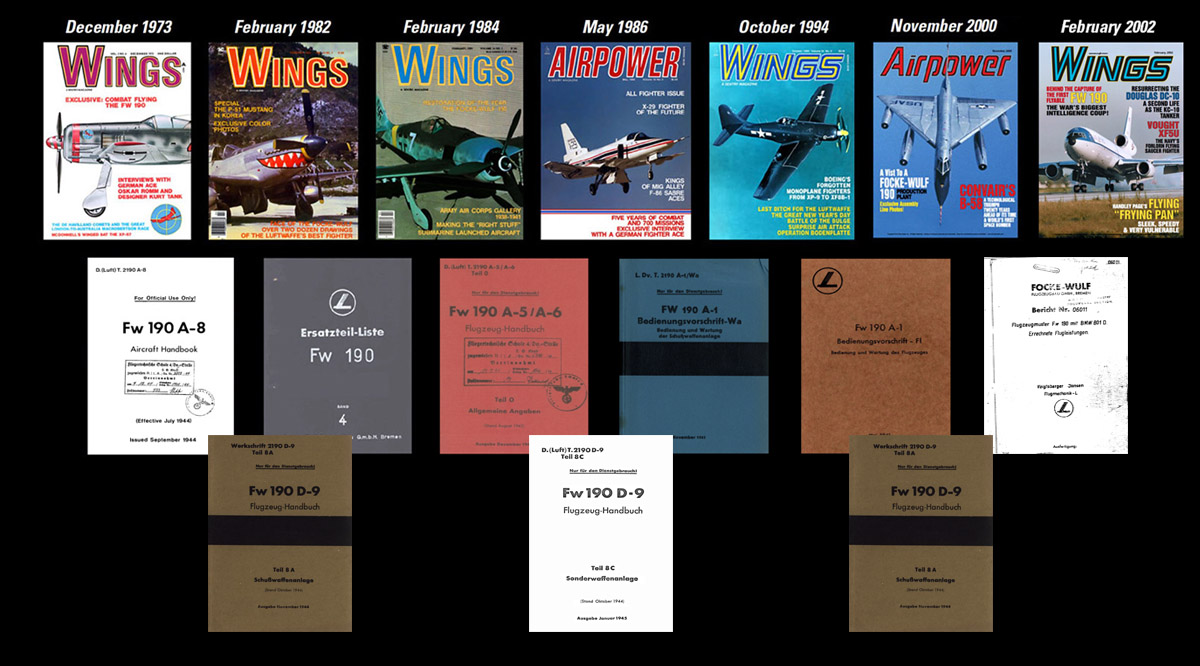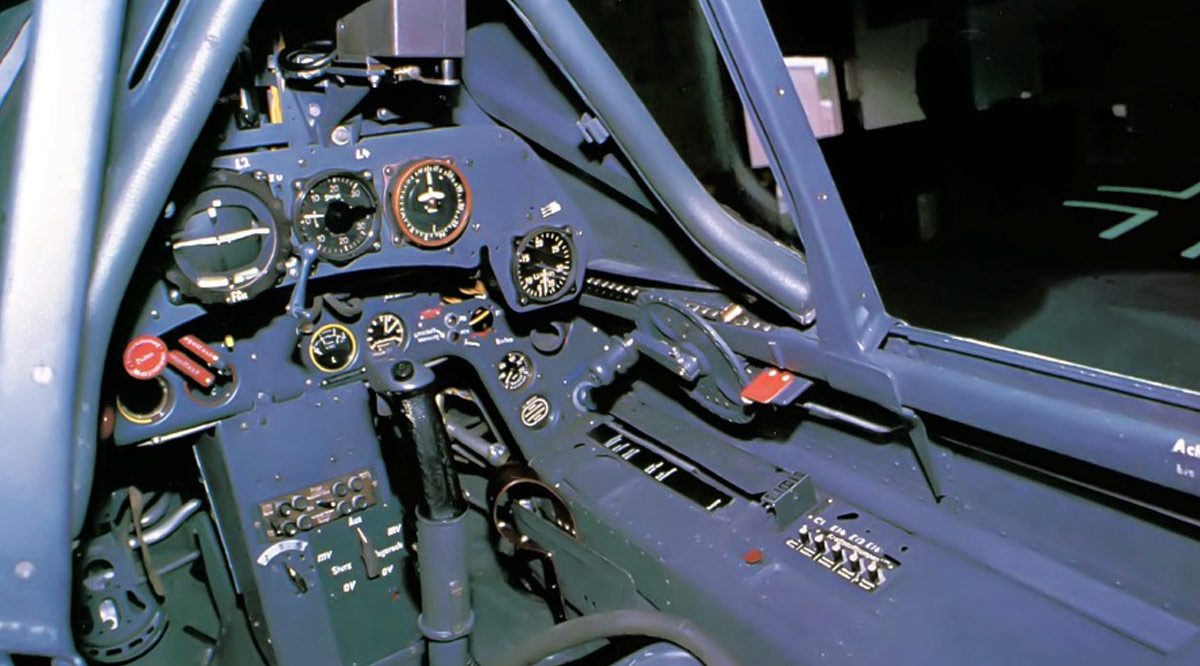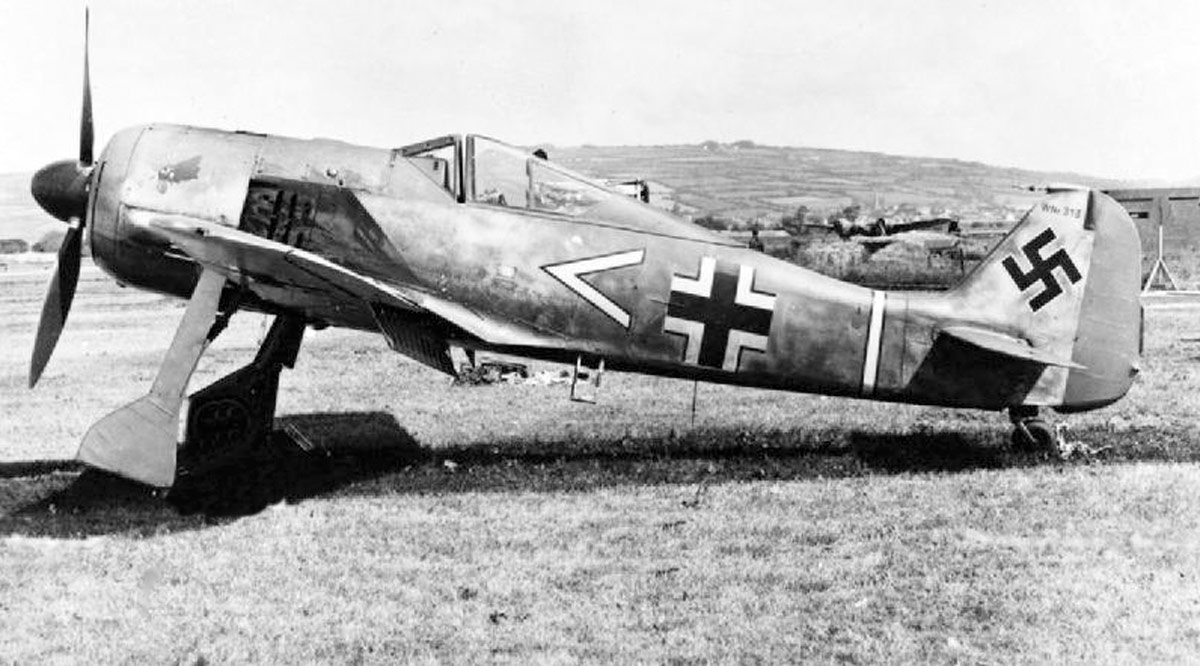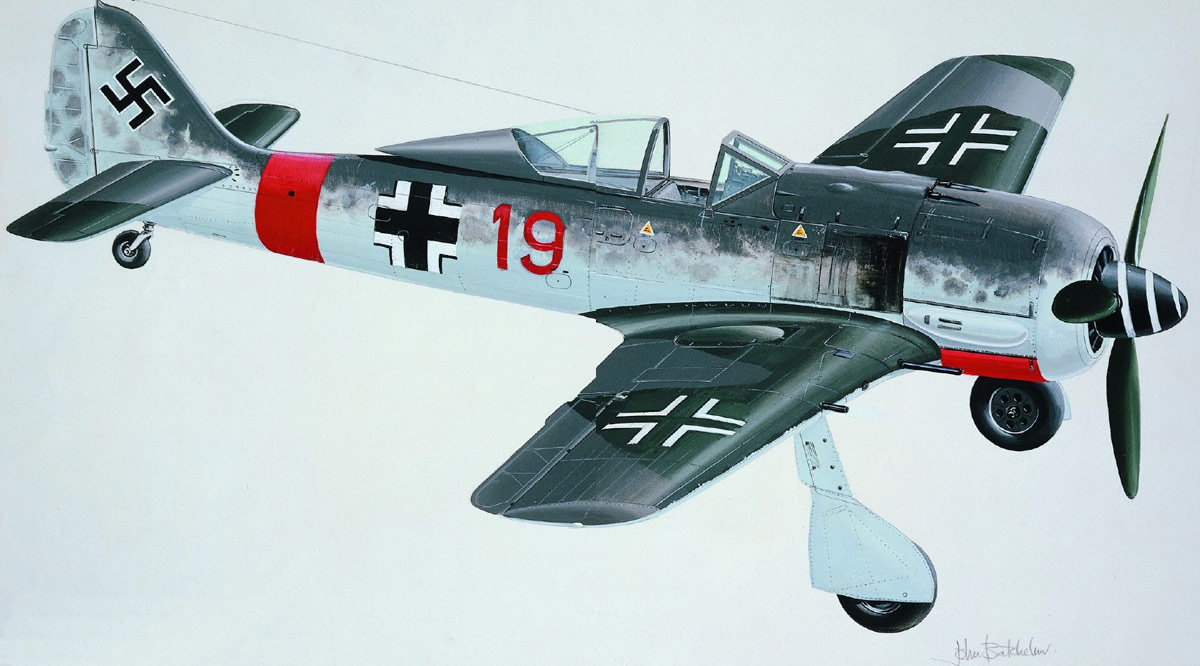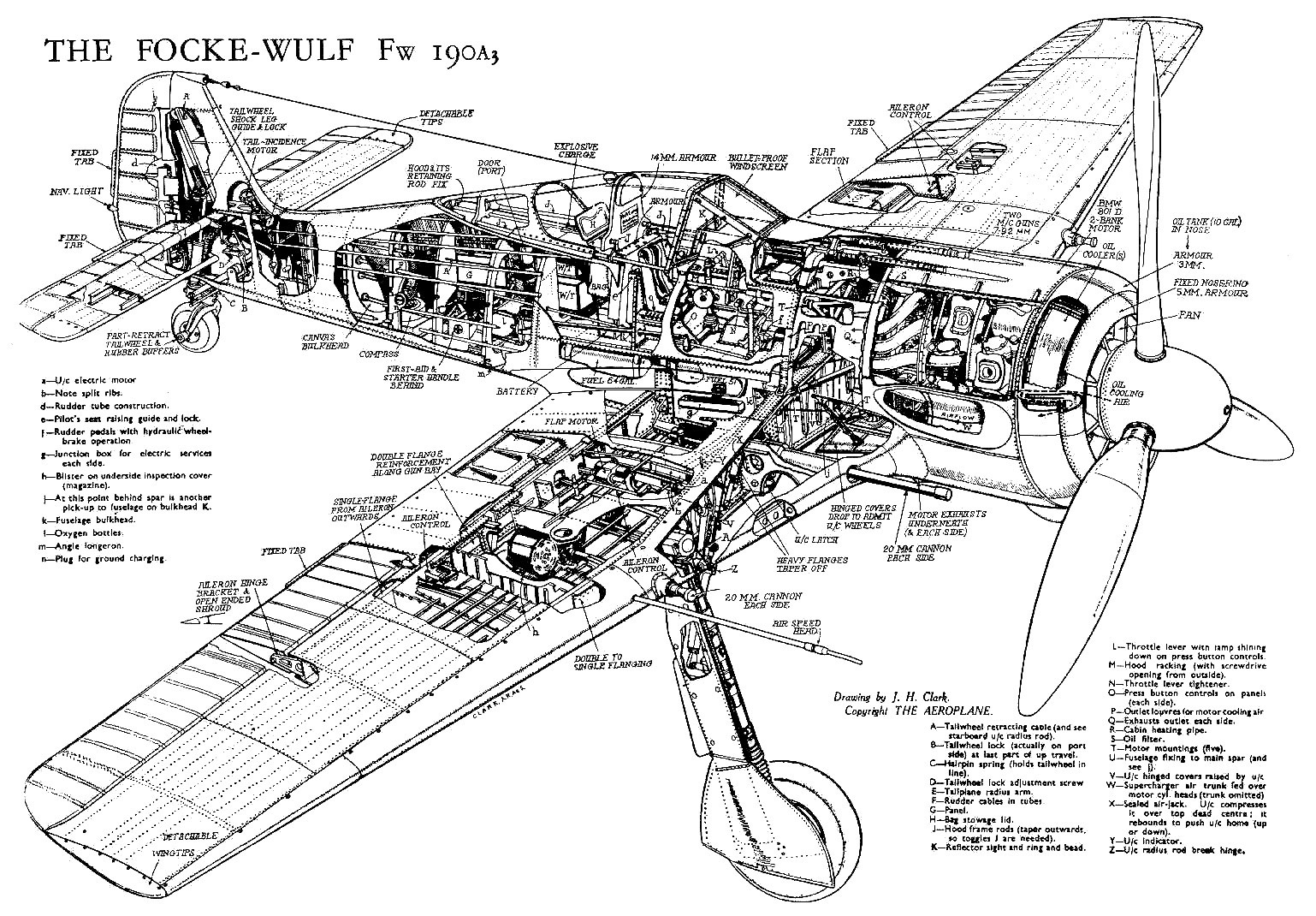Price: $29.95
- 7 magazines, 9 manuals, & photos
- PDF contains 2,140 pages
- Content is keyword searchable
- Print a personal copy
- Pay via PayPal or Credit Card
- International orders welcome!
- Download files upon payment
December 1973
- The Last Sortie, Interviews with Focke Wulf 190 Ace and Designer
- “It Might Have Been Moonbat”, Saga of McDonnell’s First Fighter
- “Fading Away”, Goodbye to the KC-97
- The First Hydroplane, Pioneering with Glenn Curtiss
February 1982
- Focke Wulf 190, Fighter of Many Faces
- The Mustang’s Last Hurrah in the Korean War
- The Gallic Goliaths, France’s Flying Monstrosities of the 1930s.
February 1984
- The Gray Eminence, The Focke Wulf 190
- A look at the aircraft in the movie “The Right Stuff”
- Dolphins with Wings, History of Submarine Launched Scout & Attack Planes
- The Way We Were, The US Air Corps in 1939-1940
May 1986
- Fighter Ace, Interview with Luftwaffe Ace Kurt Buehligen
- MiG Killers, A Second Look at the F-86
- Grumman’s X-29, The Shape of Wings to Come
October 1994
- Decision at Dawn, The Luftwaffe’s Last Ditch Gamble in the West
- Boeing’s Forgotten Fighter Brigade
November 2000
- The Devil’s Workshop, A Revealing Walk Around the Focke Wulf 190 Shop Floor
- Convair’s B-58, Diehard of the Manned Bombers
February 2002
- Behind the capture of the first flyable FW-190
- Resurrecting the Douglas DC-10
- Vought XF5U: The Navy’s Forlorn Flying Saucer Fighter
- Handley Page’s Flying “Frying Pan”
Manuals & Photos
- Fw-190 A-8 Handbook, 1944 (English)
- Fw-190 A-5/A-6 Flight Handbook 1944 (German)
- Fw-190 A-1 Control & Maintenance of Weapon System, 1941 (German)
- Fw-190 A-1 Operating Instructions, 1941 (German)
- Fw-190 Calculated Flight Performance, 1944 (German)
- Fw-190 D-9 Aircraft Manual, 1944 (German)
- Fw-190 D-9 Special Weapon System, 1945 (German)
- Fw-190 D-9 Teil 8A Firearms Conditioning, 1944 (German)
- Fw-190 Spare Parts Vol. 4, 1944 (German)
- Over 235 photos of the Focke Wulf Fw-190
Focke-Wulf Fw-190
Fw-190 D-9 Specs
Fw 190 A-8 Specs
Variants
Survivors
Cutaway
General Characteristics
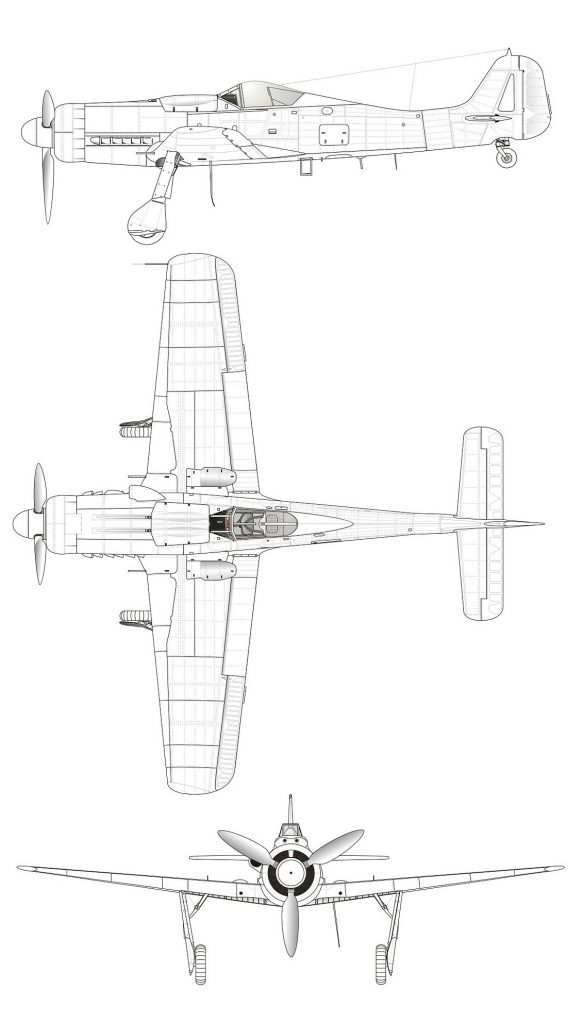
- Crew: 1
- Length: 10.20 m (33 ft 5½ in)
- Wingspan: 10.50 m (34 ft 5 in)
- Height: 3.35 m (11 ft 0 in)
- Wing area: 18.30 m² (196.99 ft²)
- Empty weight: 3,490 kg (7,694 lb)
- Loaded weight: 4,270 kg (9,413 lb)
- Max. takeoff weight: 4,840 kg (10,670 lb)
- Powerplant: 1 × Junkers Jumo 213A 12-cylinder inverted-Vee piston engine, 1,287 kW (1,750 PS, 1,726 hp) or 1,508 kW (2,050 PS, 2,022 hp) with boost (model 213E)
Performance
- Maximum speed: 685 km/h (426 mph) at 6,600 m (21,655 ft), 710 km/h (440 mph) at 11,000 m (36,000 ft)
- Range: 835 km (519 mi)
- Service ceiling: 12,000 m (39,370 ft)
- Rate of climb: 17 m/s (3,300 ft/min)
- Wing loading: 233 kg/m² (47.7 lb/ft²)
- Power/mass: 0.30–0.35 kW/kg (0.18–0.22 hp/lb)
Armament
- Guns: (all synchronized to fire through propeller arc)
- 2 × 13 mm (.51 in) MG 131 machine guns with 475 rpg
- 2 × 20 mm MG 151 cannons with 250 rpg in the wing root
- Bombs: 1 × 500 kg (1,102 lb) SC 500 bomb (optional)
General Characteristics
- Crew: 1
- Length: 9.00 m (29 ft 5 in)
- Wingspan: 10.51 m (34 ft 5 in)
- Height: 3.95 m (12 ft 12 in)
- Wing area: 18.30 m² (196.99 ft²)
- Empty weight: 3,200 kg (7,060 lb)
- Loaded weight: 4,417 kg (9,735 lb)
- Max. takeoff weight: 4,900 kg (10,800 lb)
- Powerplant: 1 × BMW 801 D-2 radial engine, 1,250 kW (1,700 PS, 1,677 hp)
Performance
- Maximum speed: 656 km/h (408 mph) at 19,420 ft (5,920 m)
- Range: 800 km (500 mi)
- Service ceiling: 11,410 m (37,430 ft)
- Rate of climb: 15 m/s (2,953 ft/min)
- Wing loading: 241 kg/m² (49.4 lb/ft²)
- Power/mass: 0.29-0.33 kW/kg (0.18-0.21 hp/lb)
Armament
- Guns:
- 2 × 13 mm (.51 in) synchronized MG 131 machine guns with 475 rounds per gun
- 4 × 20 mm MG 151/20 E cannon with 250 rpg, synchronized in the wing roots and 140 rpg free-firing outboard in mid-wing mounts.
First prototypes (BMW 139)
- Fw 190 V1 – (civil registration D-OPZE), powered by a 1,550 PS (1,529 hp, 1,140 kW) BMW 139 14-cylinder two-row radial engine. D-OPZE first flew on 1 June 1939.
- Fw 190 V2 – Designated with the Stammkennzeichen alphabetic ID code of FL+OZ (later RM+CB) the V2 first flew on 31 October 1939 and was equipped from the outset with the new spinner and cooling fan. It was armed with one Rheinmetall-Borsig 7.92 mm (.312 in) MG 17 machine gun and one 13 mm (.51 in) synchronized MG 131 machine gun in each wing root.
- Fw 190 V3 – Abandoned
- Fw 190 V4 – Abandoned
Later prototypes (BMW 801)
- Fw 190 V5 – Fitted with the larger, more powerful 14-cylinder two-row BMW 801 radial engine. This engine introduced a pioneering example of an engine management systemcalled the Kommandogerät (command-device): in effect, an electro-mechanical computer which set mixture, propeller pitch (for the constant-speed propeller), boost, and magneto timing.
- Fw 190 V5k – (kleine Fläche — small surface) The smaller span initial variant re-designated after the longer span wing was fitted. The V5 first flew in the early spring of 1940. The weight increase with all of the modifications was substantial, about 635 kg (1,400 lb), leading to higher wing loading and a deterioration in handling. Plans were made to create a new wing with more area to address these issues.
- Fw 190 V5g – (große Fläche — large surface) In August 1940 a collision with a ground vehicle damaged the V5 and it was sent back to the factory for major repairs. This was an opportune time to rebuild it with a new wing which was less tapered in plan than the original design, extending the leading and trailing edges outward to increase the area. The new wing had an area of 18.30 m² (197 ft²), and now spanned 10.506 m (34 ft 5 in). After conversion, the aircraft was called the V5g for große Fläche (large surface). Although it was 10 km/h (6 mph) slower than when fitted with the small wing, V5g was much more manoeuvrable and had a faster climb rate. This new wing platform was to be used for all major production versions of the Fw 190.
- Fw 190 A-0 – The pre-production Fw 190 A-0 series was ordered in November 1940, a total of 28 being completed. Because they were built before the new wing design was fully tested and approved, the first nine A-0s were fitted with the original small wings. All were armed with six 7.92 mm (.312 in) MG 17 machine guns — four synchronisedweapons, two in the forward fuselage and one in each wing root, supplemented by a free-firing MG 17 in each wing, outboard of the propeller disc.
- Fw 190 A-1 – The Fw 190 A-1 was in production from June 1941. It was powered by the BMW 801 C-1 engine, rated at 1,560 PS (1,539 hp, 1,147 kW) for take-off. Armament included two fuselage-mounted 7.92 mm (.312 in) MG 17s and two wing root-mounted 7.92 mm (.312 in) MG 17s (in all four MG 17s synchronized to fire through the propeller arc) and two outboard wing-mounted 20 mm MG FF/Ms.
- Fw 190 A-2 – The introduction of the BMW 801 C-2 resulted in the Fw 190 A-2 model, first introduced in October 1941. The A-2 wing weaponry was updated, with the two wing root-mounted 7.92 mm (.312 in) MG 17s being replaced by 20 mm MG 151/20E cannon.
- Fw 190 A-3 – The Fw 190 A-3 was equipped with the BMW 801 D-2 engine, which increased power to 1,700 PS (1,677 hp, 1,250 kW) at takeoff. The A-3 retained the same weaponry as the A-2.
- Fw 190 A-3/Umrüst-Bausatz 1 (/U1) — (W.Nr 130270) was the first 190 to have the engine mount extended by 15 cm (6 in), which would be standardized on the later production A-5 model.
- Fw 190 A-3/U2 — The A-3/U2 (W.Nr 130386) had RZ 65 73 mm (2.87 in) rocket launcher racks under the wings with three rockets per wing. There were also a small number of U7 aircraft tested as high-altitude fighters armed with only two 20 mm MG 151 cannon, but with reduced overall weight.
- Fw 190 A-3/U3 — The A-3/U3 was the first of the Jabo (Jagdbomber), using an ETC-501 centre-line bomb rack able to carry up to 500 kg (1,100 lb) of bombs or, with horizontal stabilising bars, one 300 L (80 US gal) drop tank. The U3 retained the fuselage-mounted 7.92 mm (.312 in) MG 17s and the wing-mounted 20 mm MG 151 cannon, with the outer MG FF being removed.
- Fw 190 A-3/U4 — The A-3/U4 was a reconnaissance version with two RB 12.5 cameras in the rear fuselage and a EK 16 gun camera or a Robot II miniature camera in the leading edge of the port wing root. Armament was similar to the U3, however, and the ETC 501 was usually fitted with the standardized Luftwaffe 300 litre-capacity (80 US gal) drop tank.
- Fw 190 A-3a – (a=ausländisch — foreign) In autumn 1942, 72 new aircraft were delivered to Turkey in an effort to keep that country friendly to the Axis powers. These were designated Fw 190 A-3a, designation for export models and delivered between October 1942 and March 1943.
- Fw 190 A-4 – Introduced in July 1942, the A-4 was equipped with the same engine and basic armament as the A-3.
- Fw 190 A-4/Rüstsatz 6 (/R6) — Some A-4s were fitted with a pair of under-wing Werfer-Granate 21 (BR 21) rocket mortars, and were designated Fw 190 A-4/R6.
- Fw 190 A-4/U1 — The A-4/U1 was outfitted with an ETC 501 rack under the fuselage. All armament except for the MG 151 cannon was removed.
- Fw 190 A-4/U3 — The A-4/U3 was very similar to the U1, and later served as the prototype for the Fw 190 F-1 assault fighter.
- Fw 190 A-4/U4 — The A-4/U4 was a reconnaissance fighter, with two Rb 12.4 cameras in the rear fuselage and an EK 16 or Robot II gun camera. The U4 was equipped with fuselage-mounted 7.92 mm (.312 in) MG 17s and 20 mm MG 151 cannon.
- Fw 190 A-4/U7 — The A-4/U7 was a high-altitude fighter, easily identified by the compressor air intakes on either side of the cowling. Adolf Galland flew a U7 in the spring of 1943.
- Fw 190 A-4/U8 — The A-4/U8 was the Jabo-Rei (Jagdbomber Reichweite, long-range fighter-bomber), adding a 300 L (80 US gal) drop tank under each wing, on VTr-Ju 87 racks with duralumin fairings produced by Weserflug, and a centreline bomb rack. The outer wing-mounted 20 mm MG FF/M cannon and the cowling-mounted 7.92 mm (.312 in) MG 17 were removed to save weight. The A-4/U8 was the precursor of the Fw 190 G-1.
- Fw 190 A-4/R1 — The A-4/R1, was fitted with a FuG 16ZY radio set with a Morane “whip” aerial fitted under the port wing. These aircraft, called Leitjäger or Fighter Formation Leaders, could be tracked and directed from the ground via special R/T equipment called Y-Verfahren. More frequent use of this equipment was made from the A-5 onwards.
- Fw 190 A-5 – The A-5 was developed after it was determined that the Fw 190 could easily carry more ordnance. The D-2 engine was moved forward another 15 cm (6 in) as had been tried out earlier on the service test A-3/U1 aircraft, moving the centre of gravity forward to allow more weight to be carried aft.
- Fw 190 A-5/U2 — The A-5/U2 was designed as a night Jabo-Rei and featured anti-reflective fittings and exhaust flame dampers. A centre-line ETC 501 rack typically held a 250 kg (550 lb) bomb, and wing-mounted racks mounted 300 L drop tanks. A EK16 gun camera, as well as landing lights, were fitted to the wing leading edge. The U2 was armed with only two 20 mm MG 151 cannon.
- Fw 190 A-5/U3 — The A-5/U3 was a Jabo fighter fitted with ETC 501s for drop tanks and bombs; it too featured only two MG 151s for armament.
- Fw 190 A-5/U4 — The A-5/U4 was a “recon” fighter with two RB 12.5 cameras and all armament of the basic A-5 with the exception of the MG FF cannon.
- Fw 190 A-5/U8 — The A-5/U8 was another Jabo-Rei outfitted with SC-250 centreline-mounted bombs, under-wing 300-litre drop tanks and only two MG 151s; it later became the Fw 190 G-2.
- Fw 190 A-5/U9 — Test installation of the A-7 modifications.
- Fw 190 A-5/U12 — A special U12 was created for bomber attack, outfitted with the standard 7.92 mm (.312 in) MG 17 and 20 mm MG 151 but replacing the outer wing 20 mm MG-FF cannon with two underwing gun pods containing two 20 mm MG 151/20 each, for a total of two machine guns and six cannon.
- Fw 190 A-5/R11 — The A-5/R11 was a night fighter conversion fitted with FuG 217 Neptun (Neptune) radar equipment with arrays of three dipole antenna elements vertically mounted fore and aft of the cockpit and above and below the wings. Flame-dampening boxes were fitted over the exhaust exits. 1,752 A-5s were built from November 1942 to June 1943.
- Fw 190 A-6 – The A-6 was developed to address shortcomings found in previous “A” models when attacking U.S. heavy bombers. A structurally redesigned and lighter wing was introduced and the normal armament was increased to two MG 17 fuselage machine guns and four 20 mm MG 151/20E wing root and outer wing cannon with larger ammunition boxes.
- Fw 190 A-7 – The A-7 entered production in November 1943, equipped with the BMW 801 D-2 engine, again producing 1,700 PS (1,677 hp, 1,250 kW) and two fuselage-mounted 13 mm (.51 in) MG 131s, replacing the MG 17s.
- Fw 190 A-8 – The A-8 entered production in February 1944, powered either by the standard BMW 801 D-2 or the 801Q (also known as 801TU). The 801Q/TU, with the “T” signifying a Triebwerksanlage unitized powerplant installation, was a standard 801D with improved, thicker armour on the front annular cowling, which for all BMW 801-powered aircraft in German service incorporated the BMW-designed oil cooler, upgraded from 6 mm (.24 in) on earlier models to 10 mm (.39 in). Changes introduced in the Fw 190 A-8 also included the C3-injection Erhöhte Notleistung emergency boost system to the fighter variant of the Fw 190 A (a similar system with less power had been fitted to some earlier Jabo variants of the 190 A), raising power to 1,980 PS (1,953 hp, 1,456 kW) for a short time.
- Fw 190 A-8/R2 — The A-8/R2 replaced the outer wing 20 mm cannon with a 30 mm (1.18 in) MK 108 cannon.
- Fw 190 A-8/R4 — The A-8/R4 featured GM1 nitrous boost to the standard BMW 801 D/Q engine. GM1(nitrious oxide) injection increased power for short amounts of time, up to 10 minutes at a time. A 20 minute supply was usually carried.
- Fw 190 A-8/R8 — The A-8/R8 was similar to the A-8/R2, but fitted with heavy armour including 30 mm (1.18 in) canopy and windscreen armour and 5 mm (.2 in) cockpit armour.
- Fw 190 A-9 – First built in September 1944, the Fw 190 A-9 was fitted with the new BMW 801S rated at 2,000 PS (1,973 hp, 1,471 kW); the more powerful 2,400 PS (2,367 hp, 1,765 kW) BMW 801F-1 was still under development, and not yet available.
- Fw 190 A-10 – Late in the war, the A-10 was fitted with larger wings for better maneuverability at higher altitudes, which could have allowed additional 30 mm (1.18 in) calibre, long-barreled MK 103 cannon to be fitted.
A total of 13,291 Fw 190 A-model aircraft were produced.
High-altitude developments
- Fw 190 V12 – (an A-0) would be outfitted with many of the elements which eventually led to the B series.
- Fw 190 V13 – (W.Nr. 0036) first C-series prototype
- Fw 190 V15 – (W.Nr. 0036) second C-series prototype
- Fw 190 V16 – (W.Nr. 0036) third C-series prototype
- Fw 190 V18 – (W.Nr. 0036) fourth C-series prototype
- Fw 190 B-0 – With a turbocharged BMW 801
- Fw 190 B-1 – This aircraft was similar to the B-0, but had slightly different armament. In its initial layout, the B-1 was to be fitted with four 7.92 mm (.312 in) MG 17s and two 20 mm MG-FFs. One was fitted with two MG 17s, two 20 mm MG 151s and two 20 mm MG-FFs. After the completion of W.Nr. 811, no further Fw 190 B models were ordered.
- Fw 190 C – With a turbocharged Daimler-Benz DB 603, the tail of the aircraft had to be lengthened in order to maintain the desired centre of gravity. Four additional prototypes based on the V18/U1 followed: V29, V30, V32 and V33.
- Fw 190 D – The Fw 190 D (nicknamed Dora; or Long-Nose Dora (“Langnasen-Dora”) was intended as the high-altitude performance version of the A-series.
- Fw 190 D-0 – The first D-0 prototype was completed in October 1942 with a supercharged Junkers Jumo 213 including a pressurized cockpit and other features making them more suitable for high-altitude work.
- Fw 190 D-1 – Initial production
- Fw 190 D-2 – Initial production
- Fw 190 D-9 – The D-9 series was rarely used against heavy-bomber raids, as the circumstances of the war in late 1944 meant that fighter-versus-fighter combat and ground attack missions took priority.
- Fw 190 D-11 – Fitted with the up-rated Jumo 213F series engine similar to the Jumo 213E used in the Ta-152 H series but minus the intercooler. Two 30 mm (1.18 in) MK 108 cannons were installed in the outer wings to complement the 20 mm MG 151s in the inboard positions.
- Fw 190 D-12 – Similar to the D-11, but featured the 30 mm (1.18 in) MK 108 cannon in a Motorkanone installation firing through the propeller hub.
- Fw 190 D-13 – The D-13 would be fitted with a 20 mm MG 151/20 motor cannon.
Ground attack versions
- Fw 190 F – The Fw 190F configuration was originally tested in a Fw 190 A-0/U4, starting in May 1942, fitted with centre-line and wing-mounted bomb racks.
- Fw 190 F-1 – Early converted aircraft designated A-4/U3
- Fw 190 F-2 – Renamed A-5/U3s, of which 270 were built according to Focke-Wulf production logs and Ministry of Aviation acceptance reports.
- Fw 190 F-2 – Based on the Fw 190 A-5/U17, which was outfitted with a centreline mounted ETC 501 bomb rack, and in the Fw 190 F-3/R1, with two ETC 50 bomb racks under each wing.
- Fw 190 F-3 – The F-3 could carry a 66-Imp gal (300 liter) drop tank. A total of 432 Fw 190 F-3s were built.
- Fw 190 F-8 – The A-8 model re-designated, having a slightly modified injector on the compressor which allowed for increased performance at lower altitudes for several minutes. Armament of the Fw 190 F-8 was two 20 mm MG 151/20 cannon in the wing roots and two 13 mm (.51 in) MG 131 machine guns above the engine.
- Fw 190 F-8/U1 — long range JaBo, fitted with underwing V.Mtt-Schloß shackles to hold two of the Luftwaffe’s standardized 300 L (80 US gal) drop tanks. ETC 503 bomb racks were also fitted, allowing the Fw 190 F-8/U1 to carry one SC 250 bomb under each wing and one SC 250 bomb on the centreline.
- Fw 190 F-8/U2 — torpedo bomber was fitted with an ETC 503 bomb rack under each wing and a centre-line mounted ETC 504. The U2 was also equipped with the TSA 2 A weapons sighting system that improved the U2’s ability to attack seaborne targets with a 700 kg (1,500 lb) BT 700.
- Fw 190 F-8/U3 — heavy torpedo bomber was outfitted with an ETC 502, which allowed it to carry one BT-1400 heavy torpedo (1,400 kg (3,100 lb)). Owing to the size of the torpedo, the U3’s tail gear needed to be lengthened. The U3 also was fitted with the 2,000 PS BMW 801S engine, and the tail from the Ta 152.
- Fw 190 F-8/U4 — created as a night fighter, was equipped with flame dampers on the exhaust and various electrical systems such as the FuG 101 radio altimeter, the PKS 12 automatic pilot, and the TSA 2 A sighting system. Weapons fitted ranged from torpedoes to bombs; however, the U4 was fitted with only two MG 151/20 cannon as fixed armament.
- Fw 190 F-8/R3 — under wing mounted two 30mm MK 103 cannon.
- Fw 190 F-9 – based on the Fw 190 A-9, but with the new Ta 152 tail unit, a new bulged canopy as fitted to late-build A-9s, and four ETC 50 or ETC 70 bomb racks under the wings. According to Ministry of Aviation acceptance reports, 147 F-9s were built in January 1945, and perhaps several hundred more from February to May 1945. (Data for these months is missing and probably lost.
- Fw 190 G – The Fw 190 G was built as a long-range attack aircraft (Jagdbomber mit vergrösserter Reichweite — abbreviated JaBo Rei). Following the success of the Fw 190 F as a Schlachtflugzeug (close support aircraft), both the Luftwaffe and Focke-Wulf began investigating ways of extending the range of the Fw 190 F. Approximately 1,300 Fw 190 Gs of all variants were new built.
- Fw 190 G-1 – The G-1 was based on the A-4/U8 JaBo Rei’s. Initial testing found that if all but two wing root mounted 20 mm MG 151 cannons (with reduced ammunition load) were removed, the Fw 190 G-1 (as it was now called) could carry a 250 kg (550 lb) or 500 kg (1,100 lb) bomb on the centreline and, via an ETC 250 rack, up to a 250 kg (550 lb) bomb under each wing.
- Fw 190 G-2 – The G-2 was based on the Fw 190 A-5/U8 aircraft, similar to the G-1; the underwing drop tank racks were replaced with the much simpler V.Mtt-Schloß fittings, to allow for a number of underwing configurations.
- Fw 190 G-3 – The G-3 was based on A-6 with all but the two wing root mounted MG 151 cannons removed. The new V.Fw. Trg bombracks, however, allowed the G-3 to simultaneously carry fuel tanks and bomb loads
- Fw 190 G-3/R1 — The G-3/R1 replaced the V.Fw. Trg racks with WB 151/20 cannon pods, giving the G-3/R1 a total of six 20 mm cannon.
- Fw 190 G-3/R5 — The G-3/R5 was similar to the R1, but the V.Fw. Trg racks were removed, and two ETC 50 racks per wing were added.
- Fw 190 G-8 – The G-8 was based on the Fw 190 A-8, using the same “bubble” canopy as the F-8 and fitted with underwing ETC 503 racks that could carry either bombs or drop tanks.
- Fw 190 G-8/R4 — The G-8/R4 kit was a planned refit for the GM 1 engine boost system, but never made it into production.
- Fw 190 G-8/R5 — The G-8/R5 kit replaced the ETC 503 racks with two ETC 50 or 71 racks.
Trainer versions
- Fw 190 A-5/U1 – Several old Fw 190 A-5s were converted by replacing the MW 50 tank with a second cockpit. The canopy was modified, replaced with a new three-section unit that opened to the side. The rear portion of the fuselage was closed off with sheet metal.
- Fw 190 A-8/U1 – A similar conversion to the A-5/U1.
- Fw 190 S-5 – A-5/U1 trainers re-designated.
- Fw 190 S-8 – A-8/U1 trainers re-designated. An estimated 58 Fw 190 S-5 and S-8 models were converted or built.
Some 28 original Fw 190s are in museums or in the hands of private collectors around the world.
A variants
- Wk. Nr. 5476, a Fw 190 A-2 from JG 5, owned by Wade S. Haynes and currently located in Texas USA. It is thought to be one of the oldest Fw 190s still in existence.
- Wk. Nr. 2219, a Fw 190 A-3 from IV./JG 5, recovered from underwater location, currently being rebuilt for the Norwegian Air Force Museum. The aircraft was salvaged from the ocean off the island of Sotra, near Bergen, Norway. Its pilot had made an emergency landing in December 1943 and had scrambled to safety and was rescued soon after; his aircraft had sunk to the bottom of the sea. After its retrieval from 60 m deep water, the Fw 190, “Yellow 16,” from IV/JG 5 was only missing its canopy and the fabric-covered wing and tail surfaces.
- Wk. Nr. 151 227, a Fw 190 A-5 from IV/JG 54. Discovered in 1989 in Voibakala forest, near Saint Petersburg. Now airworthy, as of 1 December 2010, with the Flying Heritage Collection out of Seattle, Washington State, with a video of its BMW 801 engine being test run for the first time since restoration and flying in formation with the Bf 109E-3 Wk.Nr. 1342 of the FHC collection, as the first known restored Fw 190A to be flown with its original BMW radial powerplant in the 21st century.
- Wk. Nr. 550214, a Fw 190 A-6 possibly flown by III./NJG 11 as it was fitted with a FuG 217 Neptun radar system. Formerly displayed in the UK but shipped to South Africa where it is now on display at the South African National Museum of Military History.
- Wk. Nr. 550470, a Fw 190 A-6 from I./JG 26, Owned by Malcolm Laing and located in Lubbock Texas, USA.
- Wk. Nr. 170393, a Fw 190 A-8 from 6./JG 1, mostly a reconstruction built from original parts, located at the Luftfahrtmuseum, Hanover Germany.
- Wk. Nr. 173056, a Fw 190 A-8 with an unknown history, was restored in France after an 8½ year effort, and is now powered (much like the Flug Werk-created Fw 190A reproductions are) with a Shvetsov ASh-82 T engine, and accurate late-World War II style paddle-blade propeller, with the new engine’s first runs occurring in 2009. and its first flight with its Russian-sourced replacement radial on 9 October 2011.
- Wk. Nr. 173889, a Fw 190 A-8 from 7./JG 1, owned by Mark Timken, currently under restoration.
- Wk. Nr. 350177, a Fw 190 A-8 from 12./JG 5, located at the Texas Air Museum in Rio Hondo, Texas, USA.
- Wk. Nr. 730923, a Fw 190 A-8 as a NC 900, located in the Musee de L’Air in Paris France.
- Wk. Nr. 732183, a Fw 190 A-8 from 12./JG 5 as flown by Ltn Rudi Linz, a German ace with 70 victories, this aircraft was shot down over Norway by a British Mustang during the ‘Black Friday’ raid on 9 February 1945. The aircraft is displayed in the Cottbus Hangar of the Military Aviation Museum in Pungo, Virginia, USA.
- Wk. Nr. 733685, an Fw 190 A-8 that had originally been part of a Mistel S-3B composite aircraft along with a Junkers Ju-88 bomber. For a number of years it was previously located at the Imperial War Museum in London, England. In October 2013 after a short period of restoration, it went on display in the ‘Warplanes’ Hangar at the Royal Air Force Museum, Cosford, in Shropshire, England.
D variants
- Wk. Nr. 210968, a Fw 190 D-9 from 2./JG 26, under restoration for the Luftwaffe Museum in Berlin, Germany.
- Wk. Nr. 400616, a Fw 190 D-9 from flown by Uffz. Koch of the famous JG 54 “Greenhearts”. The aircraft is currently on dispay at the Hangar 10 facility, Usedom, Germany. Presently for sale by Platinum Fighter Sales for 650.000 USD.
- Wk. Nr. 601088, a Fw 190 D-9 from IV (Sturm)./JG 3 “Udet” Geschwader, captured by the US intact and labeled FE-120 and used in testing following the war. Located at the National Museum of the United States Air Force in Dayton, Ohio, USA. The aircraft is on display in the Museum’s Air Power gallery. It is on long term loan from the National Air and Space Museum.
- Wk. Nr. 836017, a Fw 190 D-13 from 1./JG 26 as flown by Major Franz Götz. After capture labelled FE-117 and later donated to the Georgia Technical University, and then fell into disrepair. Later restored in Germany by William Flugzeuge and returned to the Champlin Fighter Museum in Mesa, Arizona. It was later loaned to the Museum of Flight in Seattle, Washington when the Champlin museum closed its doors, and is now on display in Everett, Washington as a part of Paul Allen’s Flying Heritage Collection. The aircraft has been restored close to flyable condition, but it will not be flown because it is the only surviving D-13. While part of the Champlin collection the engine was run on several occasions.
F variants
- Wk. Nr. 670071, a Fw 190 F-3 from 1./SchG 1. Under restoration for the Flugplatz Museum of Cottbus, Germany.
- Wk. Nr. 5415, a Fw 190 F-8, thought to be under restoration in New Zealand and owned by the Old Flying Machine Company
- Wk. Nr. 930838, a Fw 190 F-8, currently in storage at the Yugoslav Aeronautical Museum in Belgrade.
- Wk. Nr. 931862, a Fw 190 F-8 from 9./JG 5, the “White 1” as flown by Unteroffizier Heinz Orlowski, who examined his former aircraft personally in 2005, during its restoration. Also shot down by P-51s over Norway in the “Black Friday” engagement. Originally under restoration in Kissimmee, Florida, USA by The White 1 Foundation, it was transferred to The Collings Foundation in 2012, and is still expected to be returned to airworthy status.
- Wk. Nr. 931884, a Fw 190 F-8 from I./SG 2, airframe first built by Arado as an A-4 with Wk. Nr. 640069, but later rebuilt by Fieseler as an F-8. Captured intact by the US and marked as FE-117. Flown for a number of years and later restored by the Smithsonian’s National Air and Space Museum, at whose Steven F. Udvar-Hazy Center where it is now located.
- Wk. Nr. 584219, a Fw 190 F-8/U1 converted into a two-seat unit as a VIP transport for Jagdfliegerschule 103. Captured by the RAF in Norway and later flown for testing purposes. Currently located in the Bomber Command Hall at the RAF Museum in Hendon, England. It is the only known two seat Fw 190 in existence.
